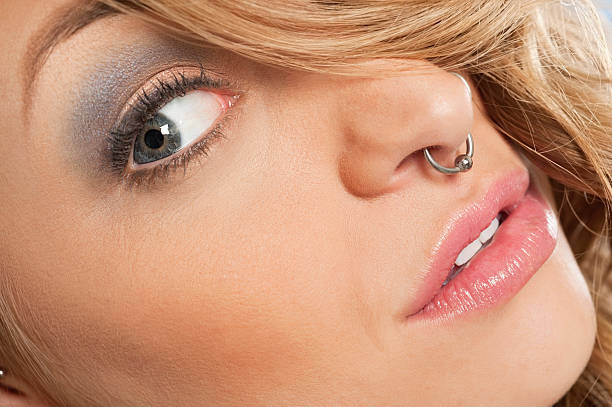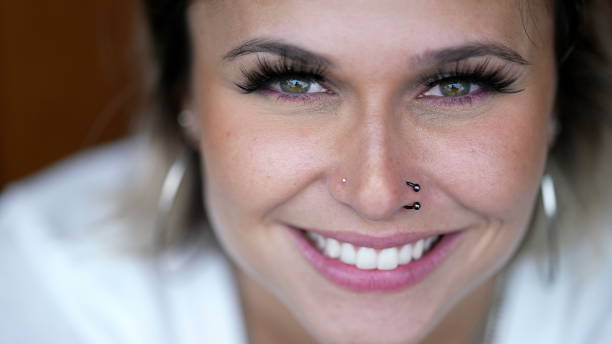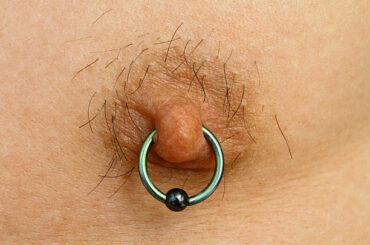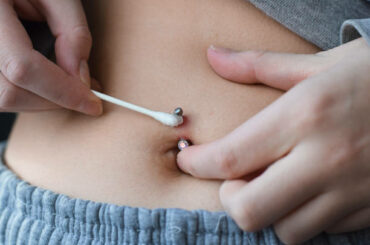Contents
Nose piercing take care.
Introduction:
Nose piercings have become increasingly popular in recent years, not only as a fashion statement but also as a form of self-expression and cultural significance. Whether it’s a delicate stud or an intricate hoop, a nose piercing can add a touch of personality and flair to one’s appearance. However, along with the excitement of getting a new piercing comes the responsibility of proper aftercare.
In this guide, we’ll delve into the world of nose piercings, exploring their popularity as a means of self-expression and adornment. More importantly, we’ll discuss the critical role that proper aftercare plays in ensuring the successful healing of a nose piercing and preventing potential complications. Understanding the importance of aftercare is key to maintaining the health and beauty of your new piercing, allowing you to enjoy it for years to come. So, let’s dive in and explore the fascinating world of nose-piercing aftercare.

Understanding Nose Piercing Aftercare:
Nose piercing aftercare is a critical aspect of the piercing process that should not be overlooked. Proper aftercare is necessary to facilitate the healing of the piercing and to prevent infections or other complications. Here’s why aftercare is essential and an overview of the healing process:
Explanation of Aftercare Necessity:
Nose piercings involve puncturing the skin, creating an open wound that is susceptible to infection. Additionally, proper aftercare can promote faster healing and reduce discomfort during the healing process.
Overview of the Healing Process:
The healing process for a nose piercing typically takes several weeks to several months, depending on individual factors such as skin type, immune response, and aftercare practices. Initially, the piercing may be tender, swollen, and slightly red, which are normal symptoms of the healing process. Over time, the swelling should gradually decrease, and the piercing should start to feel more comfortable.
Common Challenges Faced During Healing:
During the healing process, individuals may encounter various challenges, including:
Pain and Discomfort: It’s normal to experience some pain or discomfort, especially in the first few days after getting pierced.
Swelling: Swelling is a common side effect of the body’s natural healing response. To reduce swelling, avoid touching or moving the piercing unnecessarily, and apply a cold compress as needed.
Redness and Irritation: The piercing site may appear red or irritated, particularly in the initial stages of healing. This is normal and should gradually improve with proper aftercare.
Infection: While rare, infections can occur if proper aftercare practices are not followed.
Understanding the healing process and being prepared for potential challenges can help individuals navigate the aftercare process more effectively and ensure the successful healing of their nose piercing. By following proper aftercare guidelines and being attentive to any changes or concerns, individuals can minimize the risk of complications and enjoy their new piercing safely.
Cleanliness and Hygiene:
Maintaining cleanliness and good hygiene is paramount when it comes to caring for a nose piercing. By keeping the piercing site clean, individuals can minimize the risk of infection and promote optimal healing. Here’s how to ensure proper cleanliness and hygiene during the aftercare process:
Importance of Keeping the Piercing Site Clean:
The piercing site is a vulnerable area that is prone to bacteria and other pathogens. Keeping it clean is essential to prevent infections, which can delay healing and lead to complications. Regular cleaning helps to remove dirt, oil, and bacteria from the skin around the piercing, reducing the risk of infection and promoting faster healing.
Instructions for Cleaning the Piercing:
To clean the piercing, follow these steps:
Gently cleanse the area around the piercing with a mild antibacterial soap or saline solution. Use a clean cotton swab or pad to apply the soap or solution, taking care to avoid harsh scrubbing.
Pat the area dry with a clean, disposable paper towel or allow it to air dry completely.
Tips for Maintaining Good Hand Hygiene:
In addition to keeping the piercing site clean, it’s essential to maintain good hand hygiene to prevent contamination. Here are some tips:
Wash your hands frequently with warm water and soap, especially before touching or cleaning the piercing.
Avoid touching the piercing unnecessarily, as this can introduce bacteria and other pathogens.
If you need to adjust or clean the piercing, wash your hands thoroughly beforehand to minimize the risk of contamination.
Use hand sanitizer when handwashing facilities are not available, but remember that hand sanitizer is not a substitute for proper handwashing.
By following these guidelines for cleanliness and hygiene, individuals can help ensure the successful healing of their nose piercing and reduce the risk of complications. Consistent cleaning and good hand hygiene are essential components of effective aftercare, allowing individuals to enjoy their new piercing safely and comfortably.
Salt Soaks for Healing:
Salt soaks are an effective and soothing method for promoting the healing of nose piercings. The gentle cleansing action of saline solution helps to keep the piercing site clean, reduce inflammation, and accelerate the healing process. Here’s everything you need to know about using salt soaks for nose piercing aftercare:
Explanation of Benefits:
Salt soaks offer several benefits for healing nose piercings, including:
Cleansing: The saline solution helps to cleanse the piercing site, removing debris, and preventing infection.
Reducing Inflammation: Salt soaks can help to reduce swelling and inflammation around the piercing, providing relief from discomfort.
Promoting Healing: By creating an optimal environment for healing, salt soaks can help speed up the recovery process and minimize the risk of complications.
Step-by-Step Guide:
Here’s how to prepare and apply a saline solution for salt soaks:
Start by mixing non-iodized sea salt with warm water to create a saline solution. The recommended ratio is 1/4 teaspoon of salt per 8 ounces of water.
Once the saline solution is ready, soak a clean cotton ball or pad in the solution.
Gently apply the soaked cotton ball or pad to the piercing site, making sure to saturate the area thoroughly.
Allow the saline solution to remain in contact with the piercing for a few minutes to allow for effective cleansing and healing.
After the soak, gently pat the piercing dry with a clean, disposable paper towel or allow it to air dry completely.
Frequency and Duration:
For optimal results, salt soak sessions should be performed 2-3 times per day, ideally after washing the piercing with soap and water. Each soak session should last for about 5-10 minutes to ensure thorough cleansing and healing. Be sure to rinse the piercing with water after each salt soak to remove any residue and prevent irritation.
By incorporating salt soaks into your nose piercing aftercare routine, you can promote healing, reduce inflammation, and ensure the long-term health and beauty of your new piercing. Consistency and proper technique are key to maximizing the benefits of salt soaks and achieving a successful healing outcome.

Avoiding Touching and Twisting:
Touching or twisting a nose piercing can introduce bacteria, dirt, and oils to the healing wound, increasing the risk of infection and irritation. Resisting the urge to touch or manipulate the piercing is essential for promoting healing and preventing complications. Here’s why it’s crucial to avoid touching or twisting the piercing, along with tips for maintaining proper care:
Risks Associated with Touching or Twisting:
Introduction of Bacteria: Touching the piercing with unwashed hands can transfer bacteria to the healing wound, leading to infection.
Irritation and Inflammation: Manipulating the piercing can cause irritation, inflammation, and discomfort, delaying the healing process.
Disruption of Healing: Twisting or moving the jewelry can disrupt the delicate tissue around the piercing, slowing down the healing process and increasing the risk of scarring.
Tips for Resisting the Urge to Touch:
Be Mindful: Be mindful of your hands and avoid touching the piercing unnecessarily. Remind yourself of the importance of proper aftercare and the consequences of touching the piercing.
Keep Busy: Find activities to keep your hands occupied and distracted, such as reading, crafting, or playing games.
Cover the Piercing: If you find yourself tempted to touch the piercing out of habit, consider covering it with a bandage or adhesive dressing to serve as a reminder not to touch it.
Stay Focused: Stay focused on the healing process and the goal of achieving a beautiful, healed piercing. Visualize the outcome and remind yourself that proper aftercare is crucial for achieving that result.
Proper Techniques for Adjustment and Cleaning:
If you need to adjust or clean the piercing, follow these guidelines to minimize the risk of irritation:
Wash Your Hands: Before touching the piercing, wash your hands thoroughly with warm water and antibacterial soap.
Use Clean Tools: If necessary, use clean, sterile tools to adjust the jewelry or clean the piercing site. Avoid using your fingers, as they may introduce bacteria.
Be Gentle: Handle the piercing and jewelry gently, avoiding excessive movement or pressure. Clean the area around the piercing with a saline solution or gentle soap as needed, using a clean cotton swab or pad.
By resisting the urge to touch or twist your nose piercing and following proper aftercare guidelines, you can help ensure a smooth healing process and minimize the risk of complications. Remember that patience and diligence are key to achieving a beautiful, healed piercing. If you have any concerns or questions about your piercing, don’t hesitate to contact your piercer for guidance.

Avoiding Makeup and Harsh Products:
Applying makeup or harsh skincare products to a healing nose piercing can introduce irritants and bacteria, leading to inflammation, infection, and delayed healing. It’s essential to avoid these products during the healing process to promote optimal healing and reduce the risk of complications. Here’s why avoiding makeup and harsh products is crucial, along with recommendations for gentle alternatives:
Potential Risks of Applying Makeup or Harsh Skincare Products:
Irritation and Sensitivity: Makeup and skincare products often contain harsh chemicals and fragrances that can irritate the delicate skin around the piercing, leading to redness, swelling, and discomfort.
Clogged Pores: Makeup products, particularly those with heavy or oily formulations, can clog pores around the piercing, hindering airflow and impeding the healing process.
Bacterial Contamination: Applying makeup to a healing piercing can introduce bacteria and other pathogens to the wound, increasing the risk of infection and complications.
Recommendations for Gentle, Non-Comedogenic Products:
Non-Comedogenic Makeup: Look for makeup products labeled as non-comedogenic, which means they are formulated to avoid clogging pores and causing breakouts. Opt for lightweight, oil-free formulations that won’t interfere with the healing process.
Mineral Makeup: Mineral makeup products are often gentle and suitable for sensitive skin. Choose mineral-based foundations, powders, and blushes that are free from harsh chemicals and additives.
Hypoallergenic Skincare: Use hypoallergenic and fragrance-free skincare products that are gentle on the skin and unlikely to irritate. Look for gentle cleansers, moisturizers, and sunscreen specifically formulated for sensitive or reactive skin.
Water-Based Formulations: Water-based makeup and skincare products are less likely to clog pores and interfere with the healing process. Look for products with water as the primary ingredient, rather than oil or silicone.
Importance of Avoiding Alcohol-Based Products:
Alcohol-based products, such as toners and astringents, can be too harsh and dry for the delicate skin around a healing piercing. Avoid products containing alcohol, as they can strip the skin of its natural oils, disrupt the skin barrier, and delay healing. Instead, opt for gentle, alcohol-free alternatives that hydrate and soothe the skin without irritating.
By avoiding makeup and harsh products during the healing process and opting for gentle, non-comedogenic alternatives, you can help ensure a smooth healing process and reduce the risk of complications. Remember to prioritize the health and well-being of your piercing by following proper aftercare guidelines and avoiding unnecessary irritants. If you have any questions or concerns about caring for your piercing, consult with your piercer for personalized advice and recommendations.
Lifestyle Adjustments:
Adjusting your lifestyle to accommodate a healing nose piercing is crucial for promoting optimal healing and preventing complications. Certain activities and habits can irritate or damage the piercing, so it’s essential to make thoughtful adjustments during the healing process. Here are some tips for making lifestyle adjustments to support the healing of your piercing:
Advice on Making Lifestyle Adjustments:
Avoid Touching: Minimize touching or playing with the piercing to prevent irritation and the transfer of bacteria. Be mindful of your hands and refrain from unnecessary contact with the piercing site.
Limit Facial Contact: Avoid activities that involve direct contact with the face, such as facials, massages, or excessive face-touching. These activities can introduce bacteria to the piercing and disrupt the healing process.
Protect from Sun Exposure: Shield your piercing from direct sunlight and tanning beds, as UV radiation can cause irritation and prolong healing. Wear a wide-brimmed hat or apply a non-comedogenic sunscreen to protect the area.
Avoid Swimming: Refrain from swimming in pools, hot tubs, lakes, or oceans during the healing process. Submerging the piercing in water can introduce bacteria and irritants, increasing the risk of infection.
Minimize Makeup Use: Limit the use of makeup around the piercing to reduce the risk of clogged pores and irritation. If makeup is necessary, opt for non-comedogenic and hypoallergenic products.
Practice Safe Exercise: Modify your exercise routine to avoid activities that may put pressure on or irritate the piercing, such as contact sports or activities that involve sweating excessively.
Be Mindful of Clothing: Choose loose-fitting clothing that won’t rub against or irritate the piercing. Avoid wearing tight-fitting clothing, scarves, or hats that may put pressure on the piercing.
Suggestions for Avoiding Irritating Activities:
Avoid Smoking: Smoking can introduce irritants and toxins to the piercing, hindering the healing process. If possible, refrain from smoking or limit smoking near the piercing site.
Limit Alcohol Consumption: Alcohol consumption can thin the blood and increase the risk of bleeding around the piercing. Limit alcohol intake during the healing process to promote optimal healing.
Be Careful with Headphones: If using headphones, opt for over-the-ear headphones rather than earbuds that may put pressure on the piercing. Clean headphones regularly to prevent bacterial buildup.
Avoid Sleeping on the Piercing: To prevent discomfort and pressure on the piercing, avoid sleeping on your stomach or sides. Instead, sleep on your back or use a travel pillow to elevate your head and avoid direct contact with the piercing.
By making thoughtful lifestyle adjustments and avoiding activities that may irritate or damage the piercing, you can support the healing process and reduce the risk of complications. Remember to prioritize the health and well-being of your piercing by following proper aftercare guidelines and seeking guidance from your piercer if needed. With patience and care, your nose piercing will heal beautifully, allowing you to enjoy it for years to come.
Monitoring for Signs of Infection:
Monitoring a healing nose piercing for signs of infection is essential for identifying complications early and seeking prompt medical attention if needed. While infections are relatively rare with proper aftercare, it’s essential to be vigilant and aware of potential signs and symptoms. Here’s how to monitor your piercing for signs of infection and when to seek medical attention:
Common Signs and Symptoms of Infection:
Increased Pain: Persistent or worsening pain around the piercing site, especially if it feels hot or throbbing.
Redness and Swelling: Excessive redness, swelling, or inflammation that does not improve with proper aftercare.
Heat and Warmth: The area around the piercing feels warm to the touch or emits heat.
Pus or Discharge: Yellow or green discharge, pus, or fluid oozing from the piercing site.
Foul Odor: A strong, foul odor emanating from the piercing, which may indicate bacterial infection.
Fever: A fever of 100.4°F (38°C) or higher, which may accompany an infection.
Instructions for Monitoring the Piercing:
Visual Inspection: Regularly inspect the piercing site for any changes in appearance, such as redness, swelling, or discharge. Use a clean mirror or ask someone to assist you in examining hard-to-see areas.
Physical Examination: Gently touch the area around the piercing to check for tenderness, warmth, or pain. Be careful not to apply excessive pressure or manipulate the piercing unnecessarily.
Daily Observations: Make it a habit to observe the piercing daily during your aftercare routine. Note any changes or abnormalities and document them for reference.
Guidance on When to Seek Medical Attention:
If you notice any signs or symptoms of infection, it’s essential to take action promptly. Here’s when to seek medical attention for a suspected infection:
Persistent Symptoms: If symptoms persist or worsen despite proper aftercare measures, such as cleaning and saline soaks.
Severe Symptoms: If you experience severe pain, swelling, or discharge, especially if accompanied by fever or chills.
Pus or Discharge: If you notice pus, yellow or green discharge, or foul-smelling fluid oozing from the piercing site.
Fever: If you develop a fever of 100.4°F (38°C) or higher, it may indicate a systemic infection.
Consulting a Healthcare Provider: If you suspect that your nose piercing is infected, it’s crucial to seek medical attention from a qualified healthcare provider, such as a doctor or dermatologist. They can assess the severity of the infection and recommend appropriate treatment, such as antibiotics or wound care.
By diligently monitoring your nose piercing for signs of infection and seeking prompt medical attention if needed, you can help ensure the successful healing of your piercing and minimize the risk of complications. Remember to follow proper aftercare guidelines and prioritize the health and well-being of your piercing at all times.
Following Aftercare Instructions:
Following aftercare instructions provided by your piercer is crucial for promoting proper healing and minimizing the risk of complications. Here’s why it’s essential to adhere to aftercare guidelines, along with tips for effective communication with your piercer and the importance of patience and diligence:
Importance of Following Aftercare Instructions:
Promotes Healing: Aftercare instructions are designed to create an optimal environment for healing, reducing the risk of infection and promoting tissue regeneration.
Minimizes Complications: Proper aftercare practices help minimize the risk of complications, such as infection, excessive scarring, or jewelry migration.
Ensures Long-Term Health: Following aftercare instructions can help ensure the long-term health and integrity of your piercing, allowing you to enjoy it for years to come.
Tips for Communicating with the Piercer:
Ask Questions: If you have any questions or concerns about your piercing or aftercare instructions, don’t hesitate to reach out to your piercer for clarification. They are there to help and can provide valuable guidance based on their expertise.
Provide Updates: Keep your piercer informed of any changes or developments during the healing process, such as increased swelling, redness, or discharge. This information can help them assess the situation and provide appropriate advice or intervention if needed.
Schedule Follow-Up Appointments: Schedule follow-up appointments with your piercer as recommended to assess the healing progress and address any concerns. These appointments allow your piercer to monitor the piercing’s condition and make adjustments to the aftercare plan as necessary.
Encouragement to Be Patient and Diligent:
Patience is Key: Healing takes time, and it’s essential to be patient throughout the process. Avoid rushing the healing process or engaging in activities that may compromise the piercing’s integrity.
Consistency is Crucial: Be diligent about following aftercare practices consistently, even when the piercing starts to feel better. Consistency is key to ensuring successful healing and minimizing the risk of setbacks.
Trust the Process: Trust in the aftercare instructions provided by your piercer and have confidence in your body’s ability to heal. Stay positive and focused on achieving a beautiful, healed piercing.
By following aftercare instructions provided by your piercer, maintaining open communication, and practicing patience and diligence, you can support the healing process and enjoy a healthy, beautiful piercing. Remember that your piercer is there to support you every step of the way, so don’t hesitate to reach out if you have any questions or concerns. With proper care and attention, your nose piercing will heal beautifully, allowing you to showcase your unique style with confidence.
Conclusion:
In conclusion, proper aftercare is essential for the successful healing of nose piercings and the prevention of complications. By following aftercare instructions provided by your piercer, maintaining open communication, and practicing patience and diligence, you can support the healing process and enjoy a healthy, beautiful piercing.
Importance of Proper Aftercare:
Proper aftercare practices create an optimal environment for healing, minimize the risk of infection, and ensure the long-term health and integrity of your piercing.
Empowerment Through Knowledge:
Armed with knowledge and understanding of aftercare principles, you are empowered to care for your piercing effectively and confidently navigate the healing process.
Encouragement to Prioritize Aftercare:
Prioritizing aftercare is crucial for ensuring a successful healing process and long-lasting enjoyment of your piercing. Stay consistent, patient, and diligent in your aftercare routine, and trust in your body’s ability to heal.
Remember that your piercer is there to support you every step of the way, so don’t hesitate to reach out if you have any questions or concerns. With proper care and attention, your nose piercing will heal beautifully, allowing you to showcase your unique style with confidence.





